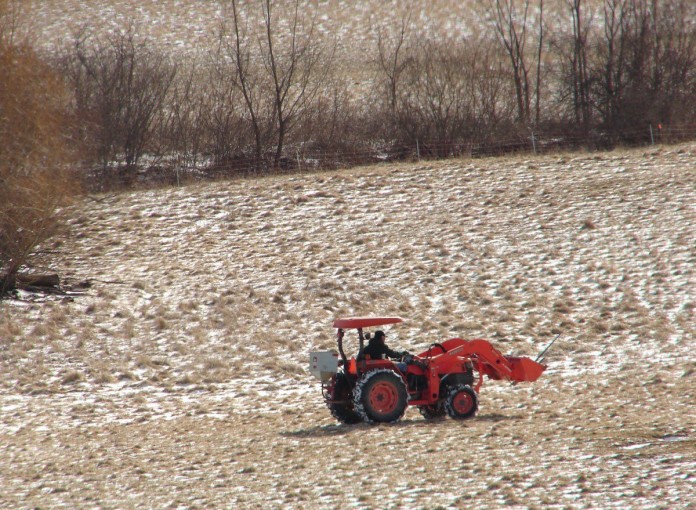I am constantly looking for signs that weather will start to turn and spring will be around the corner. There are two good signs so far.
First, we are in the average coldest week of the year, meaning average daily temperatures will slowly start to rise. Next, you may have noticed that the days are starting to get longer. Most of you have heard the “old timers” say that it melts a little bit every day in February, and I can only remember a couple exceptions over the years to that statement.
Frost seeding
This freezing and thawing over the next six weeks is what gives frost seeding a great chance to work.
Frost seeding is a very low cost, higher risk way to establish new forages in existing fields by spreading seed over the field and letting the freezing and thawing action of the soil allow the seed to make “seed to soil” contact allowing it to successfully germinate.
When you see soils “honeycombed” in the morning from a hard frost, or heaved up from a frost, seed that was spread on that soil has a great chance to make a seed to soil contact when the soil thaws.
I think the two biggest reasons why frost seeding fails is people wait too late to frost seed, and the seed never makes good contact with the soil. I have heard some say that they like to “overseed” or just spread seed over an established stand.
Let’s face it; if the seed does not land on the soil but on existing living or dead vegetation, it does not have a chance to successfully germinate: you need exposed soil.
Time for assessment
Now is the time to be assessing potential fields to frost seed. I am especially fond of frost seeding endophyte infected fescue fields where producers have issues with livestock grazing them during the summer. If you can get livestock to graze these fields in the winter, the quality and palatability is actually good, and in many cases, better than hay you may be feeding. The endophyte levels are very low now and the quality is maintained better than other forages.
If possible, abuse the field without causing environmental issues; break up the sod and expose the soil. Once that is done, go ahead and frost seed. I would rather start sooner than later, and depending on where you are located, it can start at the beginning of February through mid-March. My opinion is that once we get into March, the chance of success starts to drop depending on the weather.
What to plant
The age old question is what to plant. The seed that has the best chance to germinate and become established is red clover. For years, I recommended medium red clover but I am now convinced that no matter what we plant, use improved varieties.
Advancement in genetics is amazing. Numerous studies confirm that those varieties will last several years longer in most conditions. Forage trials at Ohio State University show there a several red clover varieties that have high yields and stand percentages 60% or greater after four years. These are more expensive varieties than some of the common, shorter-lived varieties, but I think it is worth it.
Red clover is a heavy round seed that has a better chance of making soil contact then a light flatter seed. Dr. Garry Lacefield, retired extension forage specialist from University of Kentucky says that clovers, seeded in the right conditions will germinate most years.
Grasses are more “hit or miss,” germinating about half of the time. With alfalfa, the odds are even less. Frost seeding alfalfa into an alfalfa stand rarely works as existing alfalfa is toxic to new plants. If an alfalfa field is starting to thin out, an option to extend the life of the stand would be to frost seed red clover.
Another reason to plant clover, especially red clover, is the high seedling vigor. It is tolerant of a wide range of soil pH and fertility conditions and is more drought tolerant than white clover. The advantage of frost seeding a legume like red clover is that legumes “fix” nitrogen typically in excess of their own needs, providing added fertility to other plants, improving an improved stand. Once legumes become established in a stand of grass and compose 25-30 % of the stand, there is no need to provide additional nitrogen, reducing fertility costs.
If you choose to frost seed grass, which will do best? Studies by Dan Undersander, forage specialist from University of Wisconsin indicate that perennial ryegrass will do best (note that it grows best in Ohio north of Interstate 70), followed by orchardgrass, then timothy. Other studies note that annual ryegrass will work good compared to other grasses.
Tips for success
Some other tips to help succeed include mixing with granular fertilizer when you spread the seed. The coarse fertilizer, when mixed with clover seed will “scour” the seed coat and help in germination. Keep in mind that when you use a broadcast spreader, the fertilizer will travel twice as far as seed, so plan accordingly unless you want a striped field of clover.
Over the years, I have heard people applying anywhere from 2-10 pounds of seed per acre with the lower amount applied more frequently.
Finally, grasses tend to grow earlier in the spring than legumes so where available, you could consider a light, early grazing of the grass as the clovers try to get established. You may lose some clover from the trampling, but if done right, you will set back the grass and allow the remaining clovers to establish while the grasses recover from the grazing. If you have fields with exposed soils and get the seed on early enough, I like your odds of a successful frost seeding.














i would like to frost seed a new lawn soon. can ky fescue be used in central ky